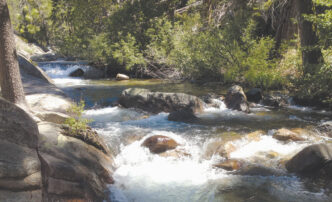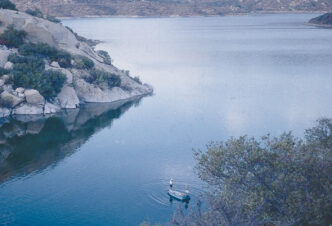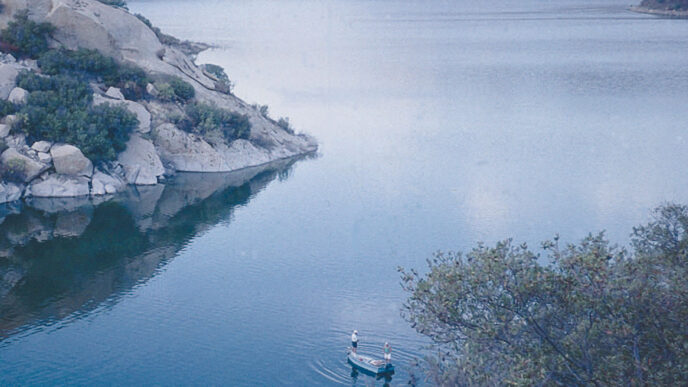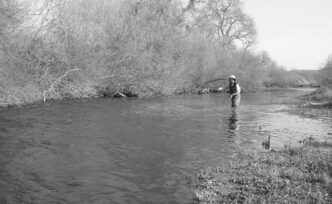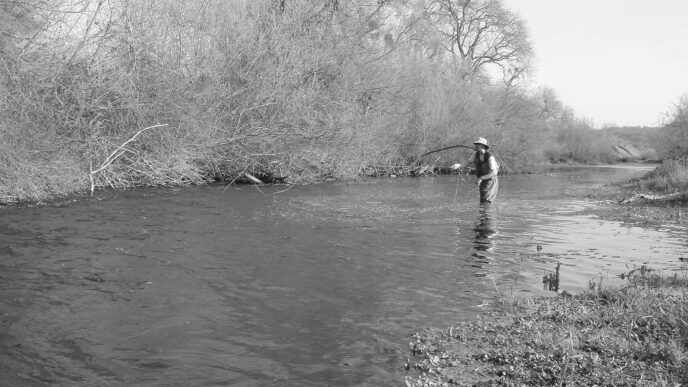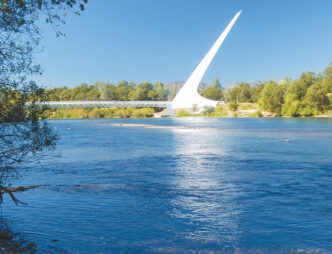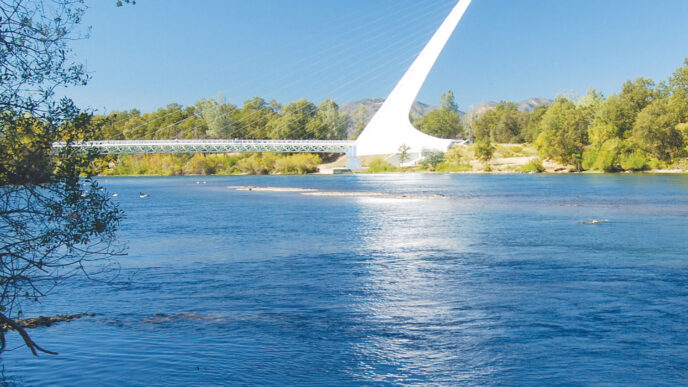Editor’s note: As always with stories that discuss small waters like creeks, there’s the chance that overuse might harm the angling experience. As a counterbalance, though, streams and lakes situated along trails are hardly unknown to the public, and perhaps can even use the thoughtful attention that conservation-minded anglers can bring. Consider, too, that California’s mountains are chock full of small waters that rarely receive anglers. Perhaps by first fishing a creek that’s easy to access, more of us will understand the pleasure such fisheries provide and the serendipity that exploration can bring.
Anyone who travels west from Echo Summit on U.S. 50 gets a brief dose of visual grandeur while descending the sweeping curve above Twin Bridges. A granite canyon similar to some parts of Yosemite surrounds a stretching white ribbon, frothing and foaming, tumbling and crashing down the steep chute below Avalanche Lake and Pyramid Peak. This vista is in large part what makes the hike up to Horsetail Falls on Pyramid Creek one of the most popular day hikes in the Lake Tahoe area and perhaps in the state.
With so many people crawling up and down the canyon day after day, I assumed that surely this would equate to relentless fishing pressure, too. But then I thought about it a little more. Although someone who lives closer to this trail and hikes it more routinely may have observed anglers in action, in my many prior trips up that canyon, only once did I observe Pyramid Creek being fished, and that was by a fly angler. The hikers focus their attention primarily on the falls.
By late morning on a typical summer day, even during the week, a seeming ant trail of hikers climbs up to the falls. The hike starts out with a gradual incline, crossing granite slopes that emerge from forested areas. The base of the falls greets hikers with a spray-laden roar in early season. Many hikers lunch and sunbathe there. On a warm summer day, it is not uncommon to see teenagers and young twentysomethings posturing and primping, seemingly competing with the falls for the honor of being the main attraction.
I had heard through the grapevine that this creek is just an also-ran as a destination for angling, but some of those sources are frequent visitors to more prominent fisheries, such as the Truckee River or Yuba River. After having made this hike many times, I started straying from the trail below Horsetail Falls, escaping the masses, taking in classic Sierra creek beauty, smelling the clear mountain air and the fragrance of the pines, and checking out the fishing. Through polarized glasses, I watched the stream carefully for the appearance of shy trout emerging from safe, concealed undercuts and the shadows of streamside brush.
On a weeklong trip to Lake Tahoe in midsummer 2012, I decided to target some of the creeks along the periphery of the Desolation Wilderness, including Pyramid Creek. My objective was to use only dry flies. That meant bypassing subsurface opportunities for larger trout, but there remains in me a young boy’s excitement in watching little trout appear from dark places in seemingly fishless pools, torpedoing a drifting dry fly. Some of these creeks seemed like sacred places. Rough hiking to secluded spots ensured relatively underfished waters and the attention of willing trout.
Pyramid Creek differs from some of the other creeks I fished on this trip, because it is in relatively open terrain that is easy to access. For the most part, there are abundant opportunities to fish there, in a setting with a spectacular backdrop. All an angler needs to fish Pyramid Creek below the falls are steady legs, the willingness to venture only a short distance off the beaten path, and realistic expectations about the fish you’ll find there. While an occasional larger trout may take up residence in one of the many plunge pools between the falls and U.S. 50, what you can mostly expect here are small trout: browns and rainbows ranging from 5 to maybe 10 inches. My takes on dry flies were mainly from small brown trout.

Some of the days I fished, I was buffeted by substantial gusts of wind, making my otherwise overmatched 9-foot 5weight a welcome partner. Minus the wind, a 3-weight will be ample for these trout and for the small, sometimes cramped quarters. A 4-weight splits the difference. Really long rods (more than 9
feet) are not much of an advantage. Pyramid Creek is not typically wide, and aside from a few situations that call for high-sticking tactics, short, well-aimed casts cover this water best. The creek’s natural topography protects some productive stretches, proving a little frustrating at first. The steep, encasing granite, carved out by millions of years of flows, can limit casting options to dapping from atop rocks. However, from these rock prominences, I could spot places that likely held trout. In more open areas, casting to productive waters in plunge pools below smaller cascades was easier. There are likely a few larger trout deep in some of those pools, but these fish let their presence remain a mystery.
The creek churns its way not only through rocky areas, but also through forested stretches where shade can cover the meandering creek, even with the sun high in the sky. Some of these areas were my favorites, offering protective lies for trout and making it more probable that they’d take dry flies at times other than dawn or dusk. Trout here were not particularly keyed in on hatches. Sure, afternoon terrestrial offerings, small and buoyant, generated some strikes, but nonspecific attractors, such as the Humpy and the Royal Coachman, also drew plenty of hits. Size 14 seemed to be sufficient, though the evidence of aging made itself known as I attempted to try a size 16. My close-range unaided eyesight at age 53 made a challenge of trying to thread a 5X tippet through a tiny eyelet. Next time, reading specs will accompany my shades.
The challenge in fishing the most trouty areas in these shaded stretches was executing casts that could land above and drift unobstructed beneath the overhanging vegetation. Some areas were hemmed in by brush and trees, some of them fallen over the creek, creating small dams holding back the crystal-clear waters. Often, short steeple casts or bow-and-arrow casts were the only way to avoid a dishonorable take by the tree monster. Pyramid Creek is not likely to be mentioned in the same sentence as the East Carson River or the Truckee River, because it is home to predominantly small, but nonetheless beautiful wild trout. The angler who will find joy on Pyramid Creek is willing to forego large trout and the concomitant necessity of sharing elbow space with other anglers. Fishing it will be a delight for someone who seeks stream time on a classic Sierra creek with a spectacular backdrop, relative ease of access, and, in places, perhaps even solitude, considering its proximity to a major trail.
If You Go…
Pyramid Creek can be accessed from Highway 50 east of Kyburz at the Twin Bridges trailhead. A $5.00 parking fee must be paid at the trailhead parking lot.
Make sure to hang the proof of purchase from your rearview mirror, unobstructed by a windshield shade on hot days. The parking lot is monitored, and tickets are issued on a regular basis for those who do not display their proof of payment. The bathrooms at the trailhead are generally very clean.
It is best to avoid midday, because the parking lot is typically full, and the fishing is not as good. By going early or later, before sundown, you should have less company and better fishing. If you live in the Sacramento metro area, as I do, Pyramid Creek is a day trip. If you live farther away or prefer a less hurried experience, you can benefit from the many lodging options in South Lake Tahoe or area campgrounds. For hikers who want to continue up the trail to reach the top of the falls and Avalanche Lake, the hike quickly steepens and becomes more technical — soon less a walk and more a scramble up rock crevices, testing route-finding skills for avoiding the ubiquitous dense brush. Some novice or armchair hikers underestimate their skills in the steep granite around the falls. Some lack experience in such terrain, while other competent, but long-idle hikers have fallen out of the shape of their younger years, their minds writing checks that their bodies can’t cash. It is regrettably commonplace to see El Dorado County’s rescue teams and paramedics on hand to retrieve injured hikers. But in spite of the inherent risks, the hike to the top of the falls is well worth the effort. Even a trip just to the base of the falls is rewarding.
If you go to the base of the falls and beyond, be sure to get a wilderness permit for entry into the Desolation Wilderness. They can be obtained at the Pacific Ranger District office, four miles east of Pollock Pines on Highway 50, (530) 647-5415, the Lake Tahoe Visitor’s Center, three miles north of the Highway 50/89 junction at South Lake Tahoe on Highway 89, (530) 543-2674 (summer only), and the Lake Tahoe Basin Management Unit, two miles east of the Highway 50/89 junction in South Lake Tahoe on Highway 50, (530)543-2600. For more information, go to the Eldorado National Forest Web site at cialplaces/?cid=fsbdev7_019070.
The nearest fly shop is Tahoe Fly Fishing Outfitters, at 2705 Lake Tahoe Boulevard in South Lake Tahoe; phone (530) 541-8208; www.TahoeFlyFishing.com.
Walt Simmons



